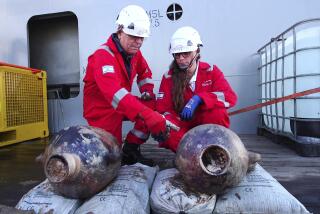Steamboat Salvage Job Has Researchers In Deep
- Share via
FORT TOWSON, Okla. — The listing steamboat, long buried in a riverbank, is broken into several pieces and mostly submerged in about 10 feet of water.
Planks from the stern and parts of the paddle wheel jut from the waters of the Red River, although the sandy river bottom shifts so much in the changing currents that different parts are exposed on different days.
The wreckage was discovered by a landowner after floods in the mid-1990s redirected the river and exposed part of the boat. Archeologists examining the remains say the unidentified vessel, which is believed to have sunk around 1838, is providing insight into early navigation of the river.
The port side is buried in up to 8 feet of sand and mud. Researchers have access to about one-third of the boat, and 90% of that is underwater.
The submerged pieces of wood and iron lasted this long because when the boat filled with sand, it created an oxygen-free environment. Parts of the flywheel, a double wooden ring about 13 feet in diameter and rimmed with iron weights, along with nails, spikes and other pieces already removed from the river, must be kept in water; they would rapidly deteriorate in the open air.
“This is a very dynamic river,” said Annalies Corbin of the Columbus, Ohio-based nonprofit foundation Partnering Archeology with Science and Technology (PAST). “There is a real possibility that the river will totally destroy it. She’s going to have a hard time making it another winter.”
The excavation is being conducted by researchers from the Oklahoma Historical Society, which has ownership of the wreckage, PAST and the Institute of Nautical Archeology at Texas A&M; University. It is expected to take two or three years.
The boat probably sank as it was carrying rations to Ft. Towson, an Army outpost established in 1824 on the border between the United States and Texas, which was then part of Mexico. The Ft. Towson ruins, just north of Hugo, Okla., are preserved as a historic site that today is maintained by the state.
Steamboat navigation of the Upper Red River began in 1838, when the government removed a logjam. Ft. Towson, a major drop site, was also a dispersion site for Chickasaw and Choctaw Indians forced along the Trail of Tears, a 1,000-mile trek from their lands in the southeastern United States to Oklahoma reservations.
Researchers get to the remote site of the wreckage by crossing several miles of privately owned pasture. Those who spent two weeks in August diving into the muddy water to document the site were surprised to learn that the boat’s hull probably began life in the 1820s as an ocean or lake schooner and was modified for river travel with a single steam engine, two paddle wheels and a deck.
The boat originally was 30 to 40 feet wide and more than 120 feet in length, researchers said. But it was too heavy and drafted too deep for the Red River, probably snagging in a sandbar or suffering mechanical failure and sinking about five miles from the fort’s supply landing.
Few blueprints exist of steamboat construction in the 1830s, when builders were trying to find a design for shallow waters. Although many sail ships were converted to steam power in the 1820s and 1830s, the Oklahoma Historical Society knows of no other deep-water ship converted to riverboat configuration.
“This is one of the last boats sailing with this technology,” said Bill Lees, the society’s project director. “It’s very important archeologically. This is significant to filling in the gaps.”
More to Read
Sign up for Essential California
The most important California stories and recommendations in your inbox every morning.
You may occasionally receive promotional content from the Los Angeles Times.










